Page 152 of 816
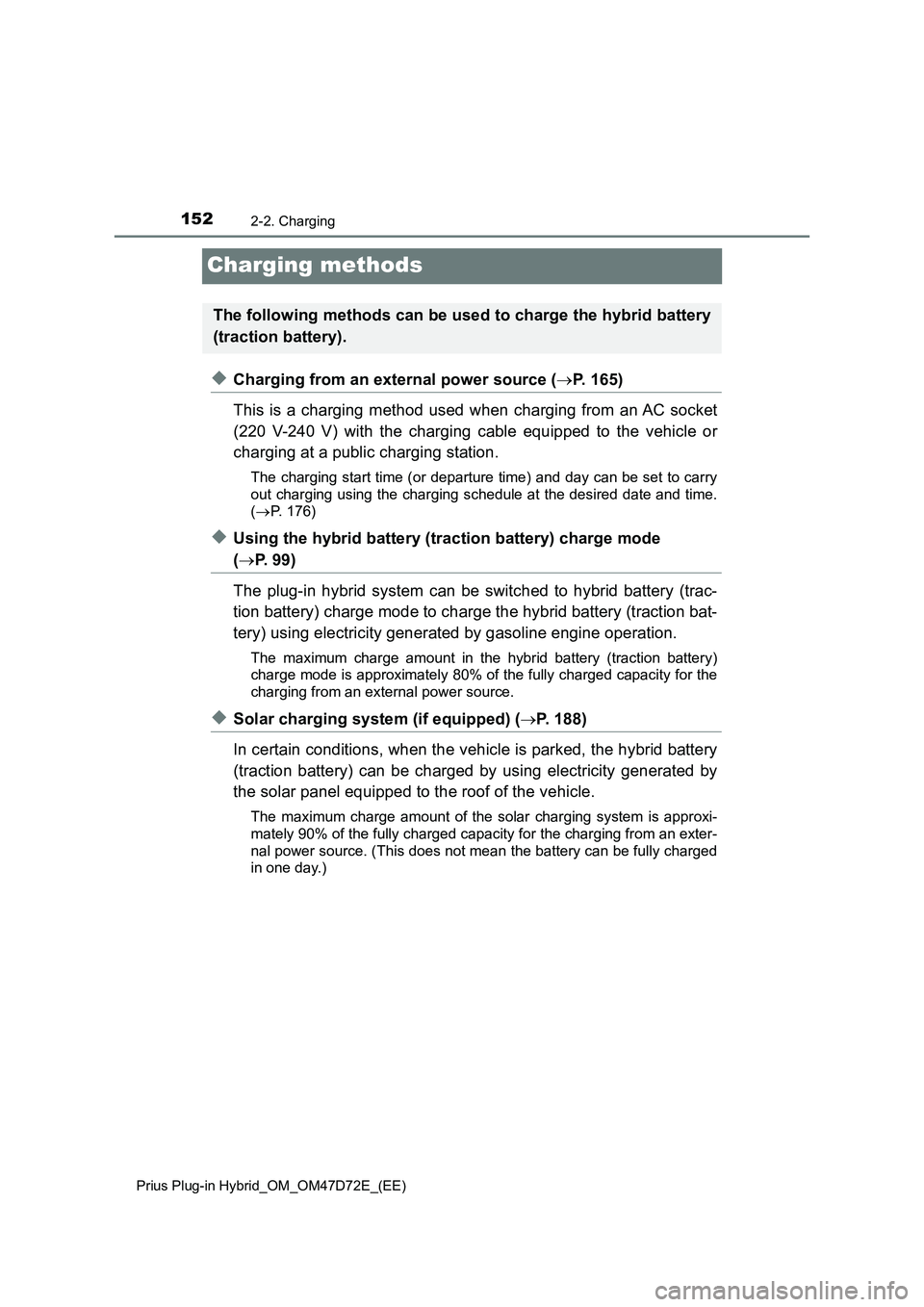
1522-2. Charging
Prius Plug-in Hybrid_OM_OM47D72E_(EE)
Charging methods
◆Charging from an external power source (P. 165)
This is a charging method used when charging from an AC socket
(220 V-240 V) with the charging cable equipped to the vehicle or
charging at a public charging station.
The charging start time (or departure time) and day can be set to carry
out charging using the charging schedule at the desired date and time.
(P. 176)
◆Using the hybrid battery (traction battery) charge mode
(P. 9 9 )
The plug-in hybrid system can be switched to hybrid battery (trac-
tion battery) charge mode to charge the hybrid battery (traction bat-
tery) using electricity generated by gasoline engine operation.
The maximum charge amount in the hybrid battery (traction battery)
charge mode is approximately 80% of the fully charged capacity for the
charging from an external power source.
◆Solar charging system (if equipped) (P. 188)
In certain conditions, when the vehicle is parked, the hybrid battery
(traction battery) can be charged by using electricity generated by
the solar panel equipped to the roof of the vehicle.
The maximum charge amount of the solar charging system is approxi-
mately 90% of the fully charged capacity for the charging from an exter-
nal power source. (This does not mean the battery can be fully charged
in one day.)
The following methods can be used to charge the hybrid battery
(traction battery).
Page 188 of 816
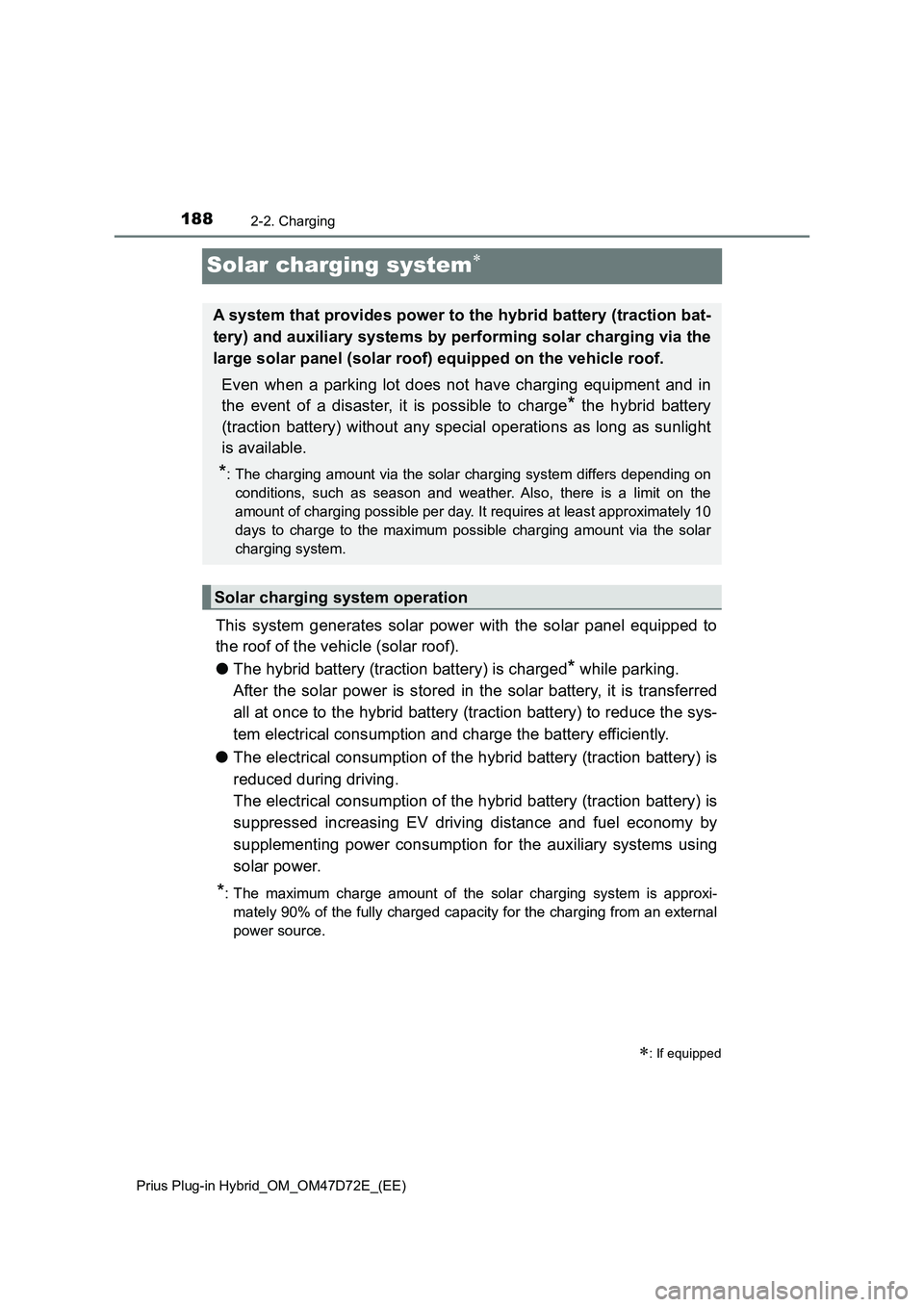
1882-2. Charging
Prius Plug-in Hybrid_OM_OM47D72E_(EE)
Solar charging system
This system generates solar power with the solar panel equipped to
the roof of the vehicle (solar roof).
●The hybrid battery (traction battery) is charged
* while parking.
After the solar power is stored in the solar battery, it is transferred
all at once to the hybrid battery (traction battery) to reduce the sys-
tem electrical consumption and charge the battery efficiently.
●The electrical consumption of the hybrid battery (traction battery) is
reduced during driving.
The electrical consumption of the hybrid battery (traction battery) is
suppressed increasing EV driving distance and fuel economy by
supplementing power consumption for the auxiliary systems using
solar power.
*: The maximum charge amount of the solar charging system is approxi-
mately 90% of the fully charged capacity for the charging from an external
power source.
: If equipped
A system that provides power to the hybrid battery (traction bat-
tery) and auxiliary systems by performing solar charging via the
large solar panel (solar roof) equipped on the vehicle roof.
Even when a parking lot does not have charging equipment and in
the event of a disaster, it is possible to charge
* the hybrid battery
(traction battery) without any special operations as long as sunlight
is available.
*: The charging amount via the solar charging system differs depending on
conditions, such as season and weather. Also, there is a limit on the
amount of charging possible per day. It requires at least approximately 10
days to charge to the maximum possible charging amount via the solar
charging system.
Solar charging system operation
Page 189 of 816
1892-2. Charging
2
Plug-in hybrid system
Prius Plug-in Hybrid_OM_OM47D72E_(EE)
12-volt battery
Solar roof
Solar battery (inside console box)
Solar ECU
Hybrid battery (traction battery)
Information related to the solar
charging system can be checked
with (Drive information) on
the multi-information display.
(P. 235, 248)
Displaying information related to the solar charging system
1
2
3
4
5
Page 190 of 816
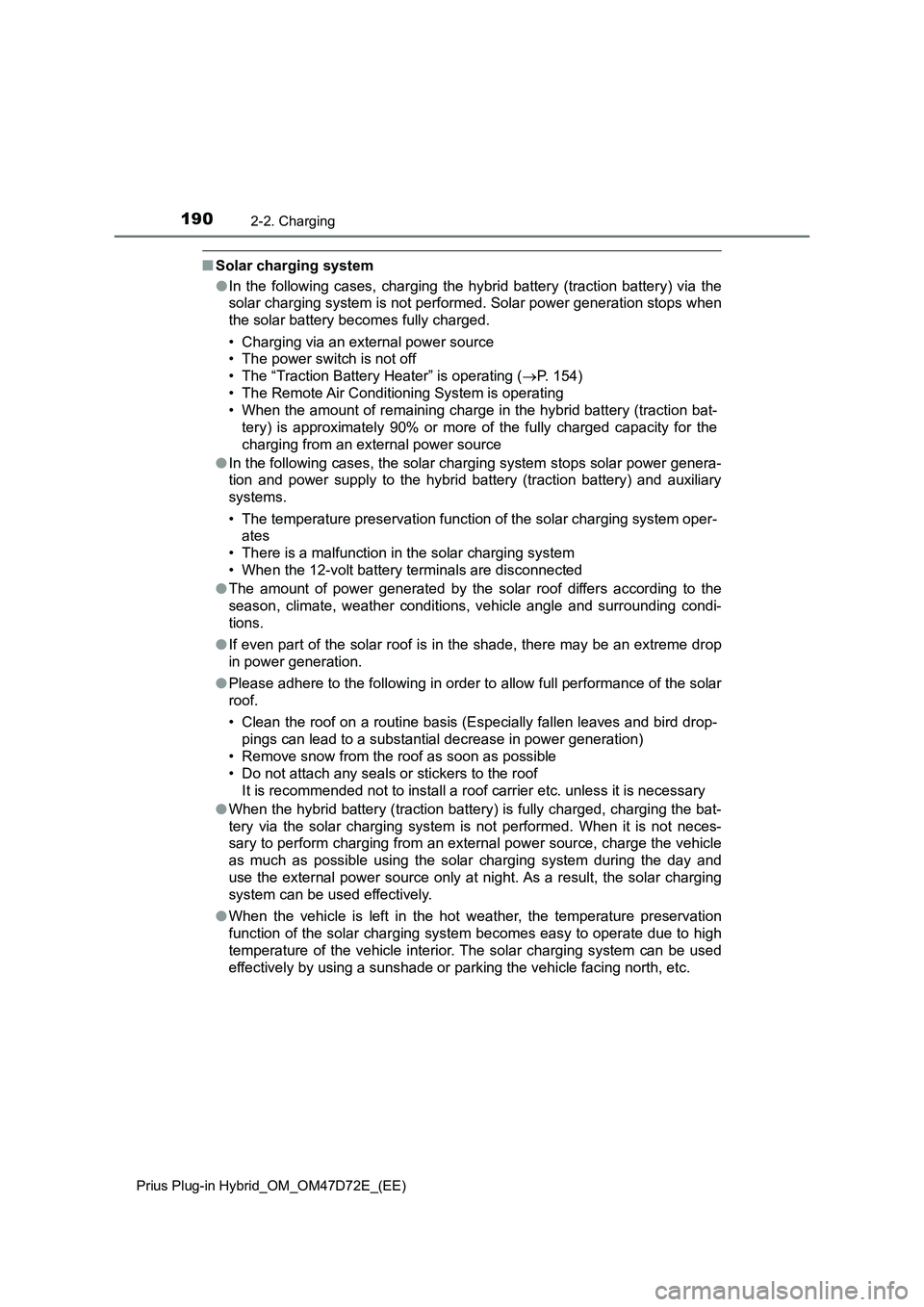
1902-2. Charging
Prius Plug-in Hybrid_OM_OM47D72E_(EE)
■Solar charging system
●In the following cases, charging the hybrid battery (traction battery) via the
solar charging system is not performed. Solar power generation stops when
the solar battery becomes fully charged.
• Charging via an external power source
• The power switch is not off
• The “Traction Battery Heater” is operating (P. 154)
• The Remote Air Conditioning System is operating
• When the amount of remaining charge in the hybrid battery (traction bat-
tery) is approximately 90% or more of the fully charged capacity for the
charging from an external power source
●In the following cases, the solar charging system stops solar power genera-
tion and power supply to the hybrid battery (traction battery) and auxiliary
systems.
• The temperature preservation function of the solar charging system oper-
ates
• There is a malfunction in the solar charging system
• When the 12-volt battery terminals are disconnected
●The amount of power generated by the solar roof differs according to the
season, climate, weather conditions, vehicle angle and surrounding condi-
tions.
●If even part of the solar roof is in the shade, there may be an extreme drop
in power generation.
●Please adhere to the following in order to allow full performance of the solar
roof.
• Clean the roof on a routine basis (Especially fallen leaves and bird drop-
pings can lead to a substantial decrease in power generation)
• Remove snow from the roof as soon as possible
• Do not attach any seals or stickers to the roof
It is recommended not to install a roof carrier etc. unless it is necessary
●When the hybrid battery (traction battery) is fully charged, charging the bat-
tery via the solar charging system is not performed. When it is not neces-
sary to perform charging from an external power source, charge the vehicle
as much as possible using the solar charging system during the day and
use the external power source only at night. As a result, the solar charging
system can be used effectively.
●When the vehicle is left in the hot weather, the temperature preservation
function of the solar charging system becomes easy to operate due to high
temperature of the vehicle interior. The solar charging system can be used
effectively by using a sunshade or parking the vehicle facing north, etc.
Page 191 of 816
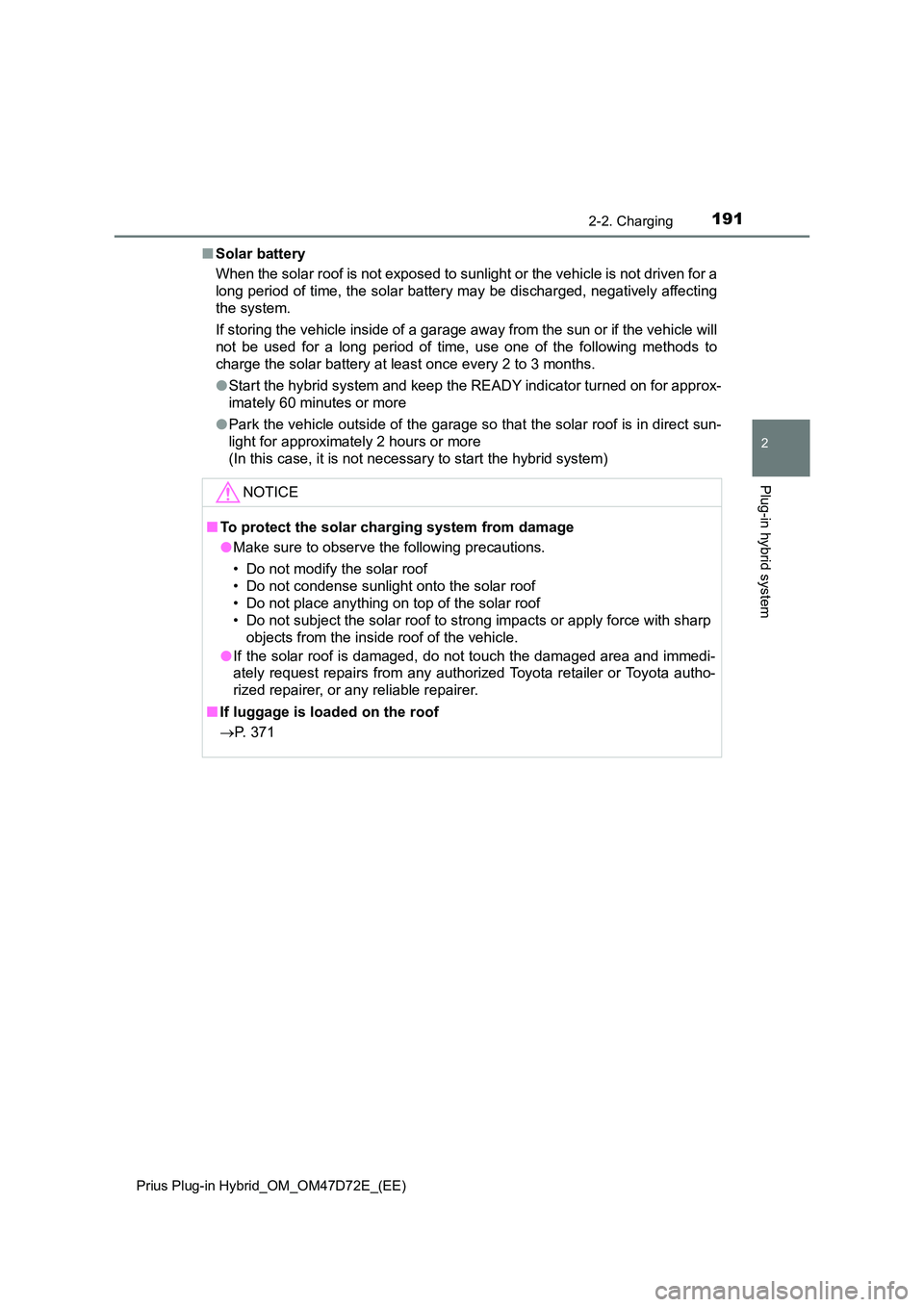
1912-2. Charging
2
Plug-in hybrid system
Prius Plug-in Hybrid_OM_OM47D72E_(EE)
■Solar battery
When the solar roof is not exposed to sunlight or the vehicle is not driven for a
long period of time, the solar battery may be discharged, negatively affecting
the system.
If storing the vehicle inside of a garage away from the sun or if the vehicle will
not be used for a long period of time, use one of the following methods to
charge the solar battery at least once every 2 to 3 months.
● Start the hybrid system and keep the READY indicator turned on for approx-
imately 60 minutes or more
● Park the vehicle outside of the garage so that the solar roof is in direct sun-
light for approximately 2 hours or more
(In this case, it is not necessary to start the hybrid system)
NOTICE
■ To protect the solar charging system from damage
● Make sure to observe the following precautions.
• Do not modify the solar roof
• Do not condense sunlight onto the solar roof
• Do not place anything on top of the solar roof
• Do not subject the solar roof to strong impacts or apply force with sharp
objects from the inside roof of the vehicle.
● If the solar roof is damaged, do not touch the damaged area and immedi-
ately request repairs from any authorized Toyota retailer or Toyota autho-
rized repairer, or any reliable repairer.
■ If luggage is loaded on the roof
P. 371
Page 235 of 816
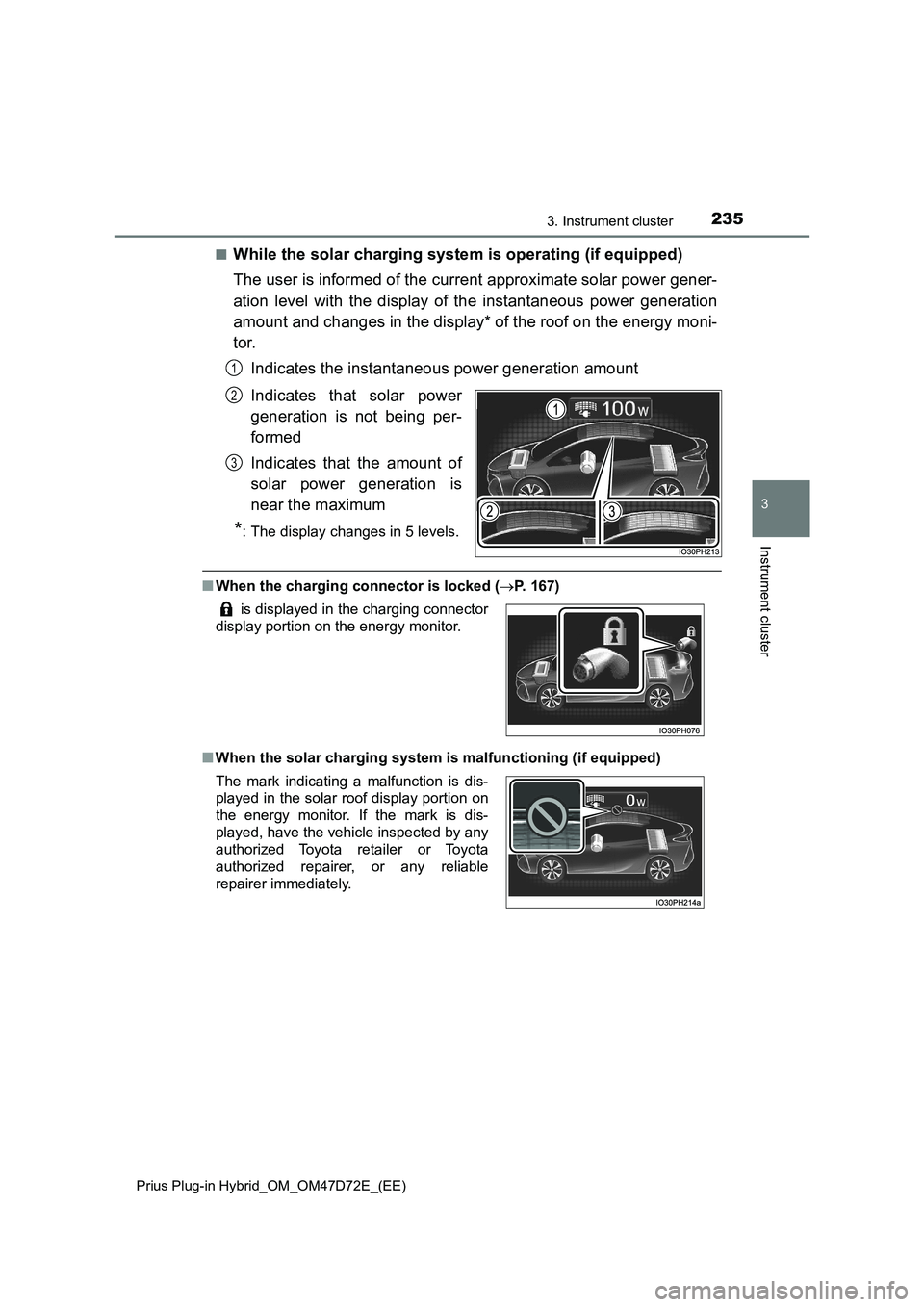
2353. Instrument cluster
3
Instrument cluster
Prius Plug-in Hybrid_OM_OM47D72E_(EE)
■While the solar charging system is operating (if equipped)
The user is informed of the current approximate solar power gener-
ation level with the display of the instantaneous power generation
amount and changes in the display* of the roof on the energy moni-
tor.
Indicates the instantaneous power generation amount
Indicates that solar power
generation is not being per-
formed
Indicates that the amount of
solar power generation is
near the maximum
*: The display changes in 5 levels.
■When the charging connector is locked (P. 167)
■When the solar charging system is malfunctioning (if equipped)
1
2
3
is displayed in the charging connector
display portion on the energy monitor.
The mark indicating a malfunction is dis-
played in the solar roof display portion on
the energy monitor. If the mark is dis-
played, have the vehicle inspected by any
authorized Toyota retailer or Toyota
authorized repairer, or any reliable
repairer immediately.
Page 371 of 816
3715-1. Before driving
Prius Plug-in Hybrid_OM_OM47D72E_(EE)
5
Driving
NOTICE
■ If luggage is loaded on the roof (vehicles with solar charging system)
Observe the following precautions. Failure to observe them could lead to
the solar roof being damaged, or the roof rack falling off.
● Do not install a roof rack which inter-
feres with the solar roof.
● Do not load luggage directly onto the
solar roof.
Page 409 of 816
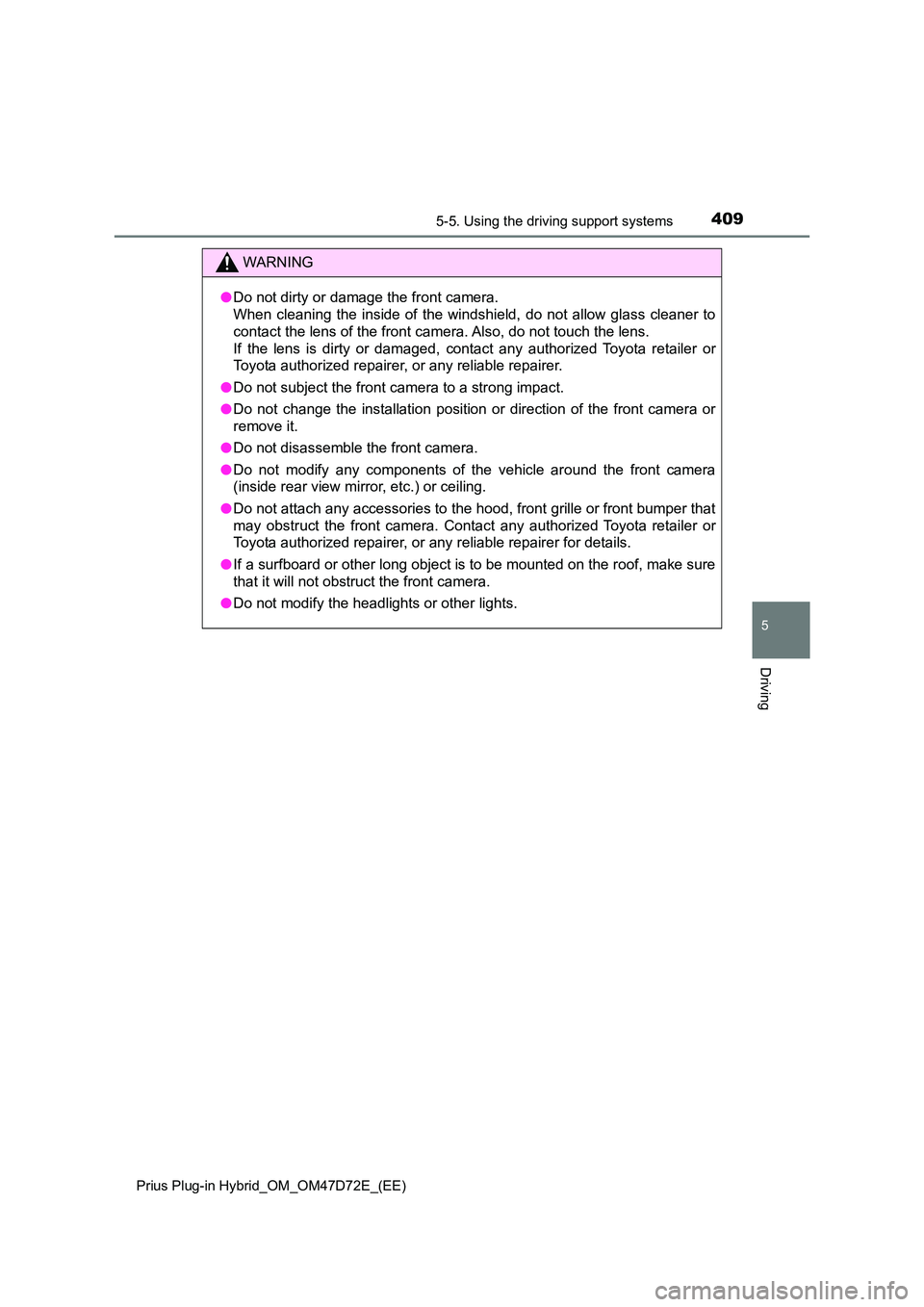
4095-5. Using the driving support systems
Prius Plug-in Hybrid_OM_OM47D72E_(EE)
5
Driving
WARNING
● Do not dirty or damage the front camera.
When cleaning the inside of the windshi eld, do not allow glass cleaner to
contact the lens of the front camera. Also, do not touch the lens.
If the lens is dirty or damaged, contact any authorized Toyota retailer or
Toyota authorized repairer, or any reliable repairer.
● Do not subject the front camera to a strong impact.
● Do not change the installation position or direction of the front camera or
remove it.
● Do not disassemble the front camera.
● Do not modify any components of the vehicle around the front camera
(inside rear view mirror, etc.) or ceiling.
● Do not attach any accessories to the hood, front grille or front bumper that
may obstruct the front camera. Contact any authorized Toyota retailer or
Toyota authorized repairer, or any reliable repairer for details.
● If a surfboard or other long object is to be mounted on the roof, make sure
that it will not obstruct the front camera.
● Do not modify the headlights or other lights.